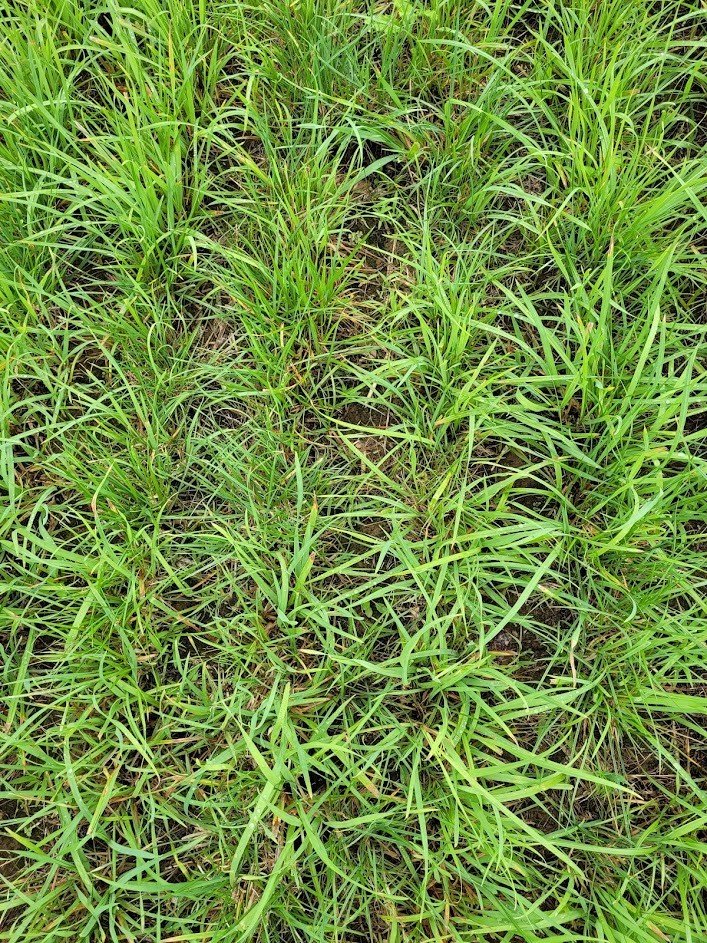by Dustin Johnson
Frost seeding is an easy and effective way to add clover to a pasture or overwintering cereal grain crop. Frost seeding is broadcasting seed on bare ground in late winter and relies on natural processes of soil freezing and thawing to “plant” the seed.
In most of the Midwest this should be done in February or early March. Planting should be late enough to minimize risks of seed being eaten or moved around by heavy rains or snow melt, but early enough to guarantee several freeze-thaw cycles to help the seed get soil contact.
For Pasture Use
Frost seeding is the easiest way to add clover without damaging the existing plants in your stand. It also works on terrain that is too steep or rocky to drill.
The picture on the left above was taken March 23 in Missouri - the field had been frost seeded with clover 1 month earlier. The field to the right - picture taken the same day - had been frost seeded the year before.
Clover naturally thins out over time in permanent pastures and should be replaced in the stand anytime it becomes less than 25% legume. Frost seeding 4-8 lbs of clover per acre will restore most thin stands to the proper balance of grass and clover in the stand.
Clover simply helps animals and grass grow better. Clover provides nitrogen for the grass and high-quality protein for grazing animals. Red clover specifically contains phytochemicals that reduce the negative effects of endophytic tall fescue on cattle.
Costs of N fertilizer and protein supplements are really expensive right now! “Grow your own” with clover.
Above is a side-by-side from a farm visit in August last year. We were there to inspect a puny field of Champion pasture mix. The poor side of the field did not have clover or N fertilizer added. The good side had clover, but still no fertilizer. Same seeding date, same harvest dates, picture taken the same day.
For Cover Crop Use
Frost seeding a clover cover crop into a stand of cereal grain has many advantages. Getting the cover crop growing before grain harvest gains up to two months of active growing season to produce forage yield and for the living clover roots to do the most good as a cover crop.
Clover will germinate before most weed species in the early spring, so its power to suppress weed growth is best utilized by frost seeding. Frost seeding clover also ensures that it will reach full bloom before being terminated for the next year’s crop.
This greatly increases it’s potential to fix nitrogen. A good stand of blooming clover can fix between 70 and 100 pounds of nitrogen per acre! This is 2-3 times more than double-crop soybeans. Frost seeding 10-12 lbs of clover per acre will achieve a stand sufficiently dense to maximize N fixation. If suppressing weeds is the primary goal, consider seeding as much as 15 lbs per acre.
Click HERE to see a more detailed article about seeding red clover into winter wheat.
What to Plant
Medium Red Clover is the frost-seeding standard. It is a first-choice because it has small, heavy seeds with very high seedling vigor. [Please note that alfalfa and forage grasses don’t work very well when frost-seeded. They should be planted using other methods later in the spring.]
Coated seed is best for this application – it makes the seed heavier and helps it avoid drying out at germination.
Start your frost seeding recipe with medium red clover and consider tweaking it for these situations:
For yield and longevity - upgrade to an improved variety such as Gallant or Bearcat.
For forage quality - Frosty berseem clover gives alfalfa-like quality for 1-2 years.
For cover crop value - Mammoth red clover and sweetclover have more aggressive roots and N-fixing ability than red clover but aren’t well suited for haying or grazing.



